Uninstall GoldenEye virus (Free Removal Instructions)
GoldenEye virus Removal Guide
Description of GoldenEye ransomware
Getting to know GoldenEye ransomware virus
GoldenEye virus is the new version[1] of Petya ransomware which has been spotted in March 2016[2]. The original version of malware has been defeated, and soon hackers decided to launch an update – Mischa ransomware[3]. However, the developers are not willing to give up on their motives to swindle the money illegally. Therefore, they launched a brand new version of malware which is supposed to be stronger and more sophisticated.. Similarly to previous variants, GoldenEye ransomware spreads via malicious spam emails that mostly targets German computer users. When a victim clicks on infected email attachment and activates Macro commands, malware sneaks inside and starts data encryption process. It’s hard to notice the time when ransomware infiltrates the system because it starts acting silently. However, as soon as it is done, malware delivers a message and the ransom note where victims are asked to pay 1.3 Bitcoins in order to get their files back. However, instead of learning about Bitcoins and how to user Tor network, we recommend focusing on GoldenEye removal. Transferring demanded sum of money might lead to both – money and data loss.
On the affected computer GoldenEye virus starts encoding files just like a regular file-encrypting virus and appends a random 8-symbol file extension to each audio or video file, picture, photography or other encoded documents. It also displays a fake check disk screen, and while users see regular Windows message claiming repairing files, it encrypts files stored on the computer’s hard drive. GoldenEye ransomware also encrypts hard drive Master File Table (MFT)[4] and modifies Master Boot Record (MBR)[5]. Then this complicated process is over, victims receive the ransom message and see the YOUR_FILES_ARE_ENCRYPTED.TXT file. As you already know, the developers of the ransomware demand to pay the ransom. According to their message, victims have no other choice just to purchase the ‘special key’ because all the files are encrypted using military grade algorithm. However, it might not be an option. Take our advice and remove GoldenEye from your PC as soon as it starts asking for your money. You should run a full system scan with FortectIntego or other reputable malware removal program, and later restore lost files from backups or using alternative data recovery methods. You can find malware elimination and data recovery instructions at the end of this article.

How does ransomware spread?
GoldenEye malware spreads similarly to its predecessors – via malicious email attachments. Hackers send infected PDF and MS Excel files. As we already mentioned, the latest version of Petya ransomware might be mostly targeting German speaking computer users. This assumption is made because it sends a malicious email written in German and has subject ‘Bewerbung.’ It’s already known that malicious file has named as Wiebold-Bewerbung.xls, Meinel-Bewerbung.xls, Seidel-Bewerbung.xls, Wüst-Bewerbung.xls, Born-Bewerbung.xls, and Schlosser-Bewerbung.xls. Once the victim opens one of these files, he or she is asked to activate Macros by clicking ‘Enable Content’ button. If user does it, malware gets inside and starts data encryption procedure. Therefore, if you want to avoid GoldenEye hijack or other ransomware viruses that are actively spreading online, you should learn to double check the information about all received emails and discussed issue. Think if you are supposed to receive this kind of email; if not, do not open the attachment! Besides, you should avoid visiting suspicious websites, clicking on each ad or link, downloading questionable software, etc. Generally, you should watch your every step online.
Is it possible to remove GoldenEye and restore files without paying the ransom?
GoldenEye removal requires using an up-to-date anti-malware program. We recommend installing FortectIntego or SpyHunter 5Combo Cleaner. However, malware might try to stop you from doing that. For this reason, we have prepared detailed and illustrated instructions how to deal with all obstacles that might encounter during the removal process. Furthermore, when you successfully remove GoldenEye from your PC, you can plug in the external device with data backups and copy them. However, if you don’t have them, take this ransomware attack as a lesson why data backups[6] are crucial nowadays. Fortunately, at the end of this article, you will find additional data recovery methods that might help you to retrieve at least some of your files. Keep in mind that malware researchers managed to defeat previous versions of the virus, so GoldenEye decryption tool might be released soon as well.
Getting rid of GoldenEye virus. Follow these steps
In-depth guide for the GoldenEye elimination
Important! →
The elimination guide can appear too difficult if you are not tech-savvy. It requires some knowledge of computer processes since it includes system changes that need to be performed correctly. You need to take steps carefully and follow the guide avoiding any issues created due to improper setting changes. Automatic methods might suit you better if you find the guide too difficult.
Step 1. Launch Safe Mode with Networking
Safe Mode environment offers better results of manual virus removal
Windows 7 / Vista / XP
- Go to Start.
- Choose Shutdown, then Restart, and OK.
- When your computer boots, start pressing the F8 button (if that does not work, try F2, F12, Del, etc. – it all depends on your motherboard model) a few times until you see the Advanced Boot Options window.
- Select Safe Mode with Networking from the list.
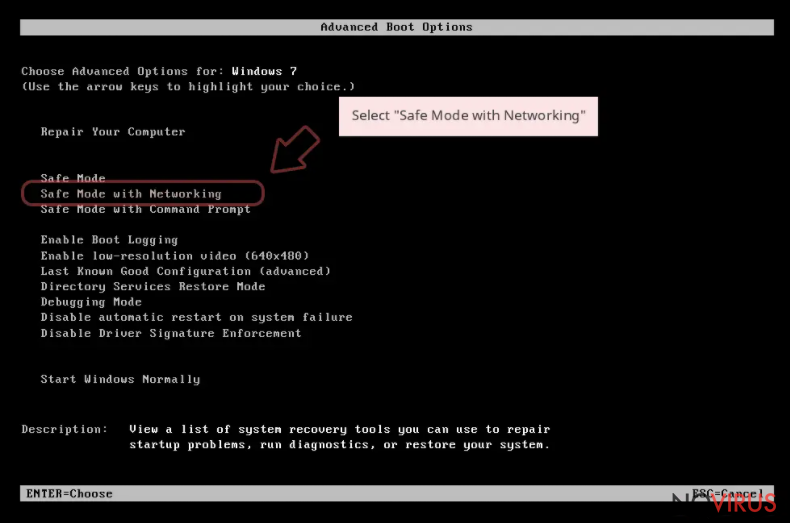
Windows 10 / Windows 8
- Right-click the Start button and choose Settings.
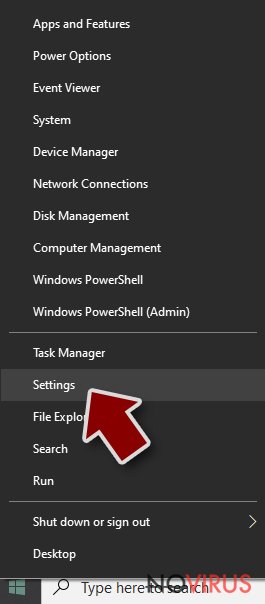
- Scroll down to find Update & Security.
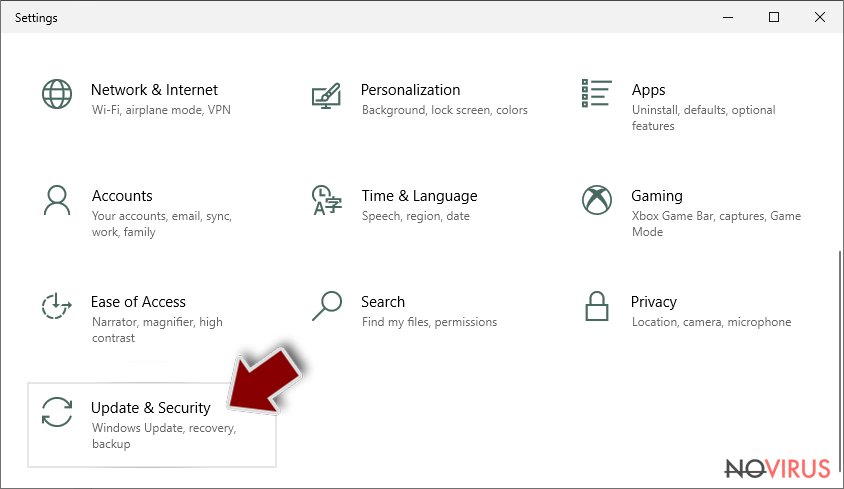
- On the left, pick Recovery.
- Scroll to find Advanced Startup section.
- Click Restart now.
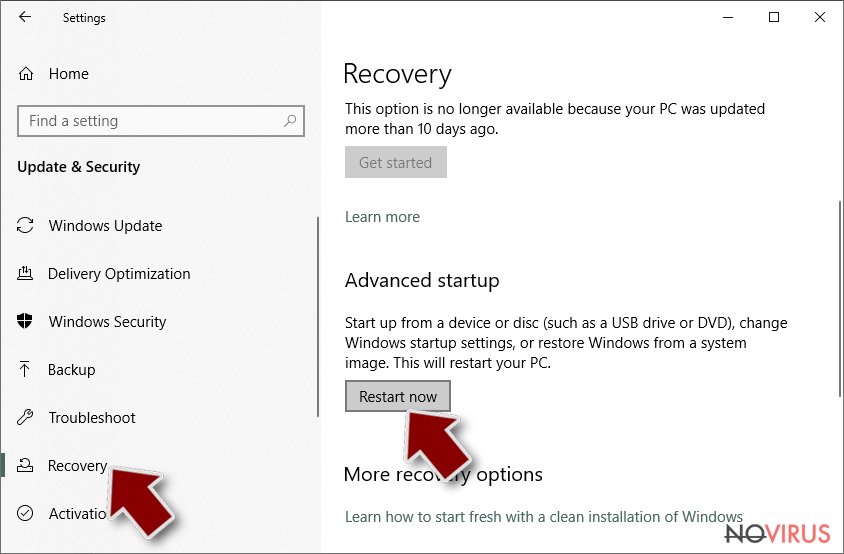
- Choose Troubleshoot.
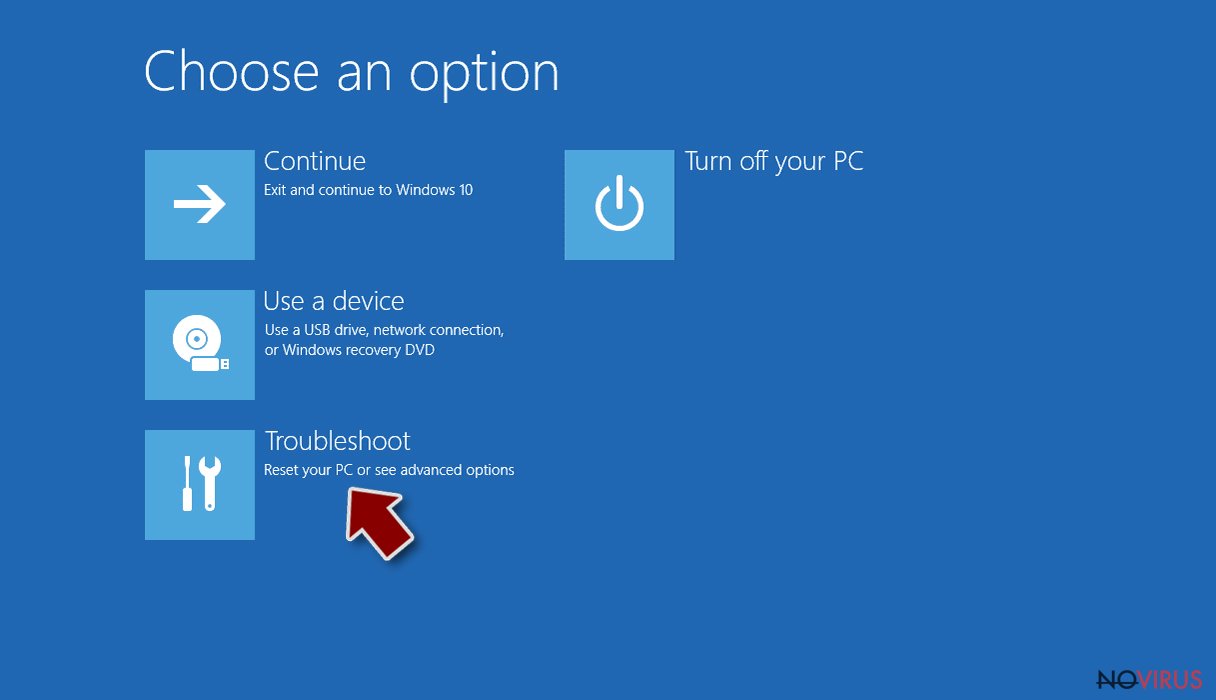
- Go to Advanced options.
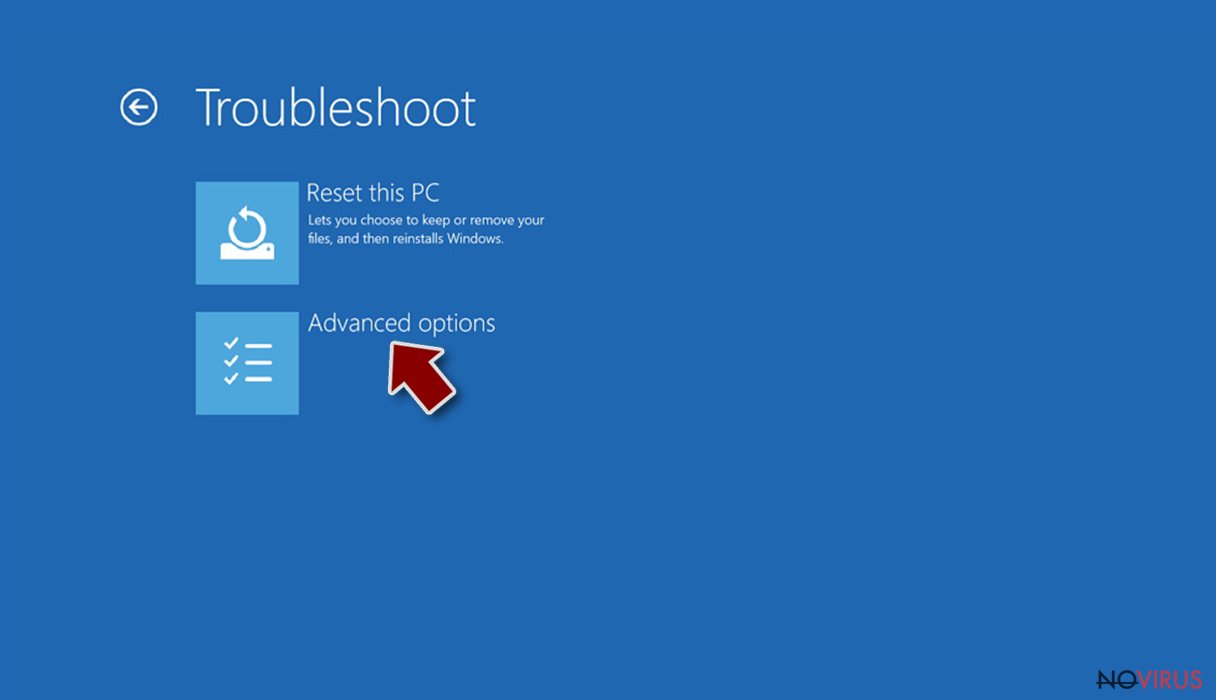
- Select Startup Settings.
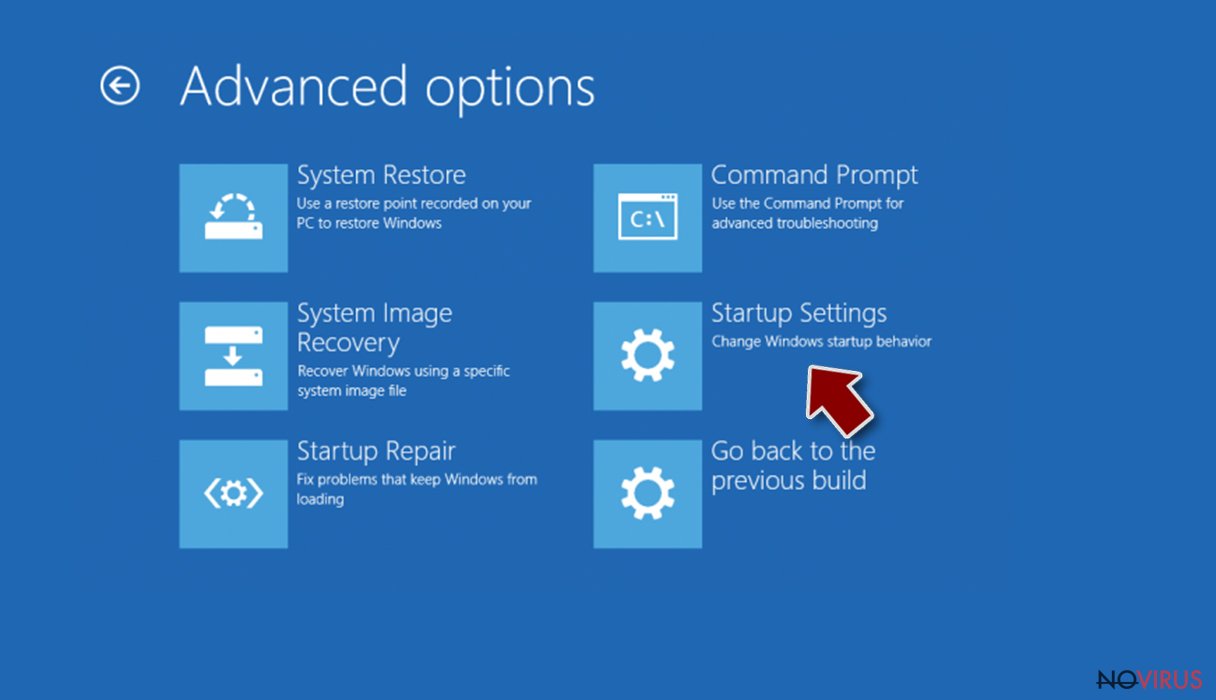
- Press Restart.
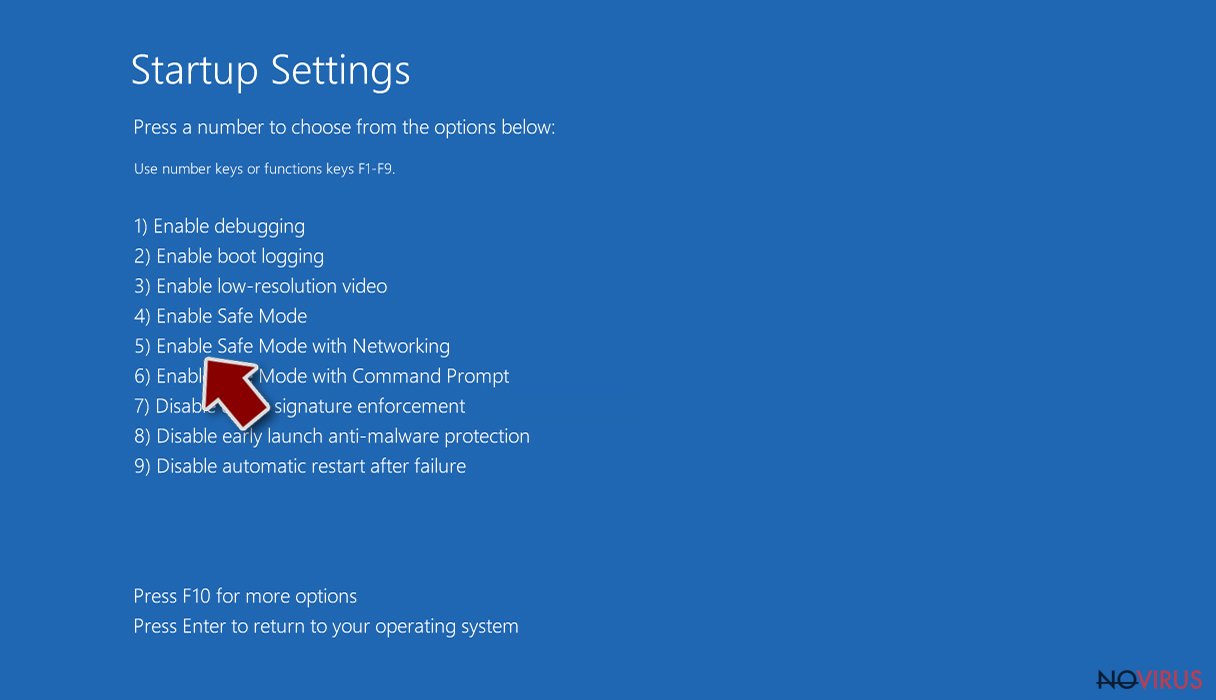
- Choose 5) Enable Safe Mode with Networking.
Step 2. End questionable processes
You can rely on Windows Task Manager that finds all the random processes in the background. When the intruder is triggering any processes, you can shut them down:
- Press Ctrl + Shift + Esc keys to open Windows Task Manager.
- Click on More details.
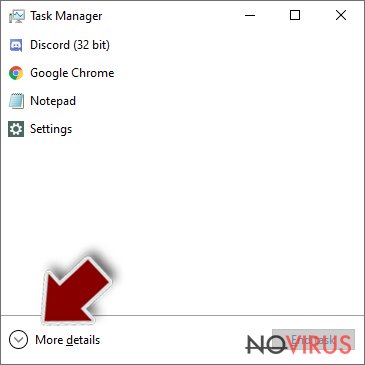
- Scroll down to Background processes.
- Look for anything suspicious.
- Right-click and select Open file location.
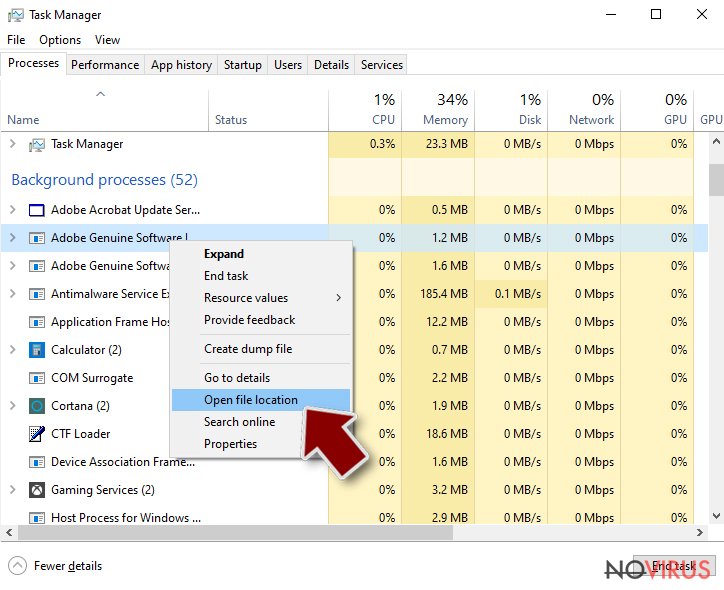
- Go back to the Process tab, right-click and pick End Task.
- Delete the contents of the malicious folder.
Step 3. Check the program in Startup
- Press Ctrl + Shift + Esc on your keyboard again.
- Go to the Startup tab.
- Right-click on the suspicious app and pick Disable.
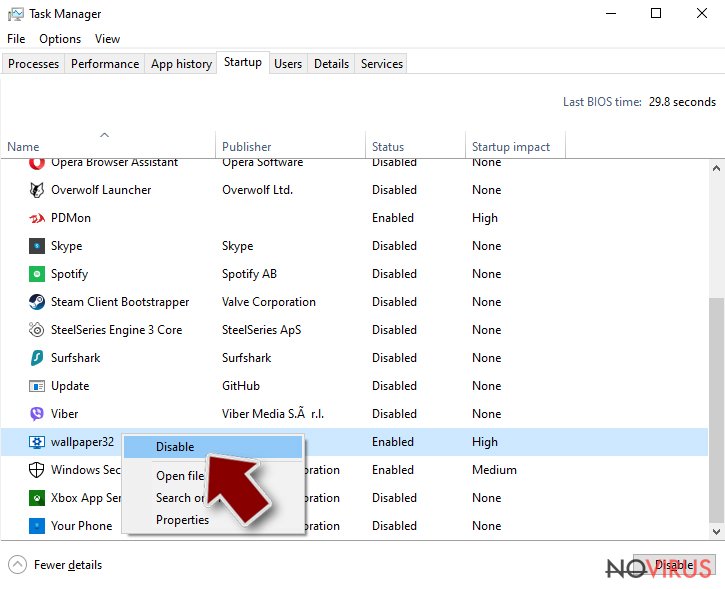
Step 4. Find and eliminate virus files
Data related to the infection can be hidden in various places. Follow the steps and you can find them:
- Type in Disk Cleanup in Windows search and press Enter.
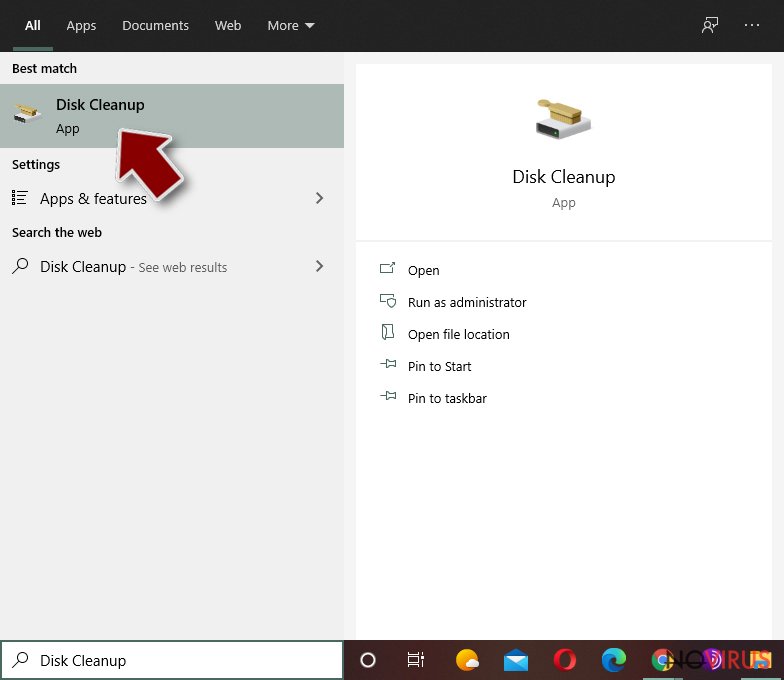
- Select the drive (C: is your main drive by default and is likely to be the one that has malicious files in) you want to clean.
- Scroll through the Files to delete and select the following:
Temporary Internet Files
Downloads
Recycle Bin
Temporary files - Pick Clean up system files.
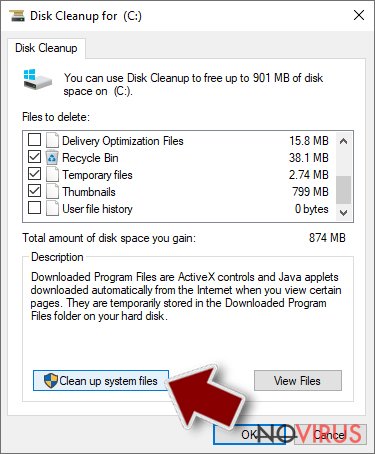
- You can also look for other malicious files hidden in the following folders (type these entries in Windows Search and press Enter):
%AppData%
%LocalAppData%
%ProgramData%
%WinDir%
After you are finished, reboot the PC in normal mode.
Eliminate GoldenEye using System Restore
-
Step 1: Restart your computer in Safe Mode with Command Prompt
Windows 7 / Vista / XP- Go to Start → Shutdown → Restart → OK.
- As soon as your computer starts, start pressing F8 key repeatedly before the Windows logo shows up.
-
Choose Command Prompt from the list

Windows 10 / Windows 8- Click on the Power button at the Windows login screen, and then press and hold Shift key on your keyboard. Then click Restart.
- Then select Troubleshoot → Advanced options → Startup Settings and click Restart.
-
Once your computer starts, select Enable Safe Mode with Command Prompt from the list of options in Startup Settings.

-
Step 2: Perform a system restore to recover files and settings
-
When the Command Prompt window appears, type in cd restore and press Enter.

-
Then type rstrui.exe and hit Enter..

-
In a new window that shows up, click the Next button and choose a restore point that was created before the infiltration of GoldenEye and then click on the Next button again.


-
To start system restore, click Yes.

-
When the Command Prompt window appears, type in cd restore and press Enter.
Bonus: Restore your files
Using the tutorial provided above you should be able to eliminate GoldenEye from the infected device. novirus.uk team has also prepared an in-depth data recovery guide which you will also find above.If you do not have data backups, we recommend you to try three additional data recovery methods that might help you to restore at least some of your files. Besides, if some encrypted files are left locked, you should back up them into external device and wait for the free decryption tool.
There are a couple of methods you can apply to recover data encrypted by GoldenEye:
Method 1: Data Recovery Pro
Data Recovery Pro is a professional tool that restores lost, damaged or encrypted files. However, it’s not a specific decryption tool for GoldenEye, it still might be useful.
- Download Data Recovery Pro;
- Install Data Recovery on your computer following the steps indicated in the software’s Setup;
- Run the program to scan your device for the data encrypted by GoldenEye ransomware;
- Recover the data.
Method 2: Windows Previous Version feature
If you have enabled System Restore function before GoldenEye attack, you should follow the steps below and restore individual files.
- Right-click on the encrypted document you want to recover;
- Click “Properties” and navigate to “Previous versions” tab;
- In the “Folder versions” section look for the available file copies. Choose the desired version and press “Restore”.
Method 3: ShadowExplorer
This method allows restoring files from Shadow Volume Copies. However, GoldenEye ransomware might have deleted them. If you are the lucky one and malware failed to delete them, follow these steps:
- Download Shadow Explorer (http://shadowexplorer.com/);
- Install Shadow Explorer on your computer following the instructions in the software’s Setup Wizard;
- Run the program. Navigate to the menu on the top-left corner and select a disk containing your encrypted files. Look through the available folders;
- When you find the folder you want to recover, right-click it and select “Export”. Also, choose where the recovered data will be stored.
It is strongly recommended to take precautions and secure your computer from malware attacks. To protect your PC from GoldenEye and other dangerous viruses, you should install and keep a powerful malware removal tool, for instance, FortectIntego, SpyHunter 5Combo Cleaner or Malwarebytes.
How to prevent from getting ransomware
Securely connect to your website wherever you are
Sometimes you may need to log in to a content management system or server more often, especially if you are actively working on a blog, website, or different project that needs constant maintenance or that requires frequent content updates or other changes. Avoiding this problem can be easy if you choose a dedicated/fixed IP address. It's a static IP address that only belongs to a specific device and does not change when you are in different locations.
VPN service providers such as Private Internet Access can help you with these settings. This tool can help you control your online reputation and successfully manage your projects wherever you are. It is important to prevent different IP addresses from connecting to your website. With a dedicated/fixed IP address, VPN service, and secure access to a content management system, your project will remain secure.
Reduce the threat of viruses by backing up your data
Due to their own careless behavior, computer users can suffer various losses caused by cyber infections. Viruses can affect the functionality of the software or directly corrupt data on your system by encrypting it. These problems can disrupt the system and cause you to lose personal data permanently. There is no such threat if you have the latest backups, as you can easily recover lost data and get back to work.
It is recommended to update the backups in parallel each time the system is modified. This way, you will be able to access the latest saved data after an unexpected virus attack or system failure. By having the latest copies of important documents and projects, you will avoid serious inconveniences. File backups are especially useful if malware attacks your system unexpectedly. We recommend using the Data Recovery Pro program to restore the system.
- ^ Justin Luna. Petya ransomware returns with new GoldenEye variant, exploiting macros. Neowin. Technology industry news.
- ^ Sean Gallagher. New ransomware installs in boot record, encrypts hard disk [Updated]. Ars Technica. News and reviews, analysis of technology trends.
- ^ Olivia Morelli. Mischa ransomware virus. How to Remove?. 2-spyware. Website about malware and virus removal.
- ^ Master File Table. Microsoft. Developer resources.
- ^ Master Boot Record. Wikipedia. The Free Encyclopedia.
- ^ Data Backup - What is it and why should you be doing it?. Risc IT Solutions Blog. Blog about cyber security and industry news.







